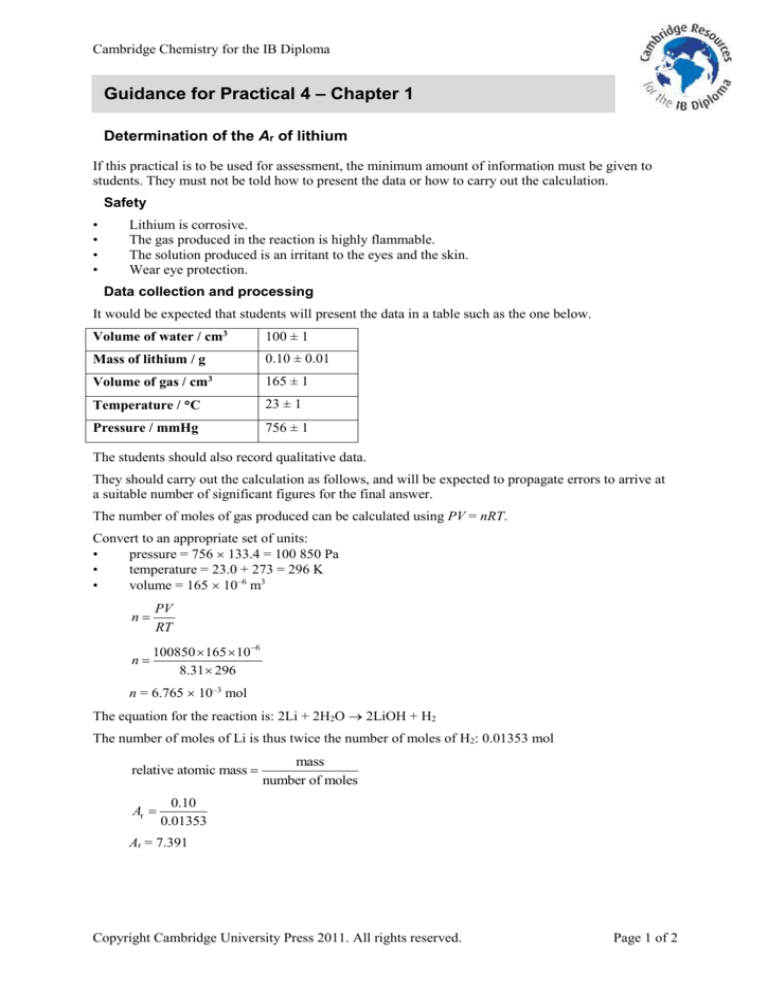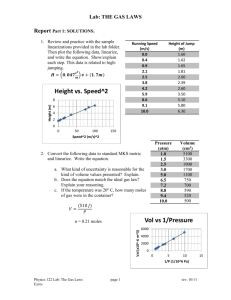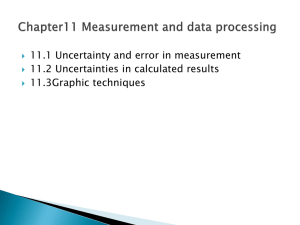
Cambridge Chemistry for the IB Diploma
Guidance for Practical 4 – Chapter 1
Determination of the Ar of lithium
If this practical is to be used for assessment, the minimum amount of information must be given to
students. They must not be told how to present the data or how to carry out the calculation.
Safety
•
•
•
•
Lithium is corrosive.
The gas produced in the reaction is highly flammable.
The solution produced is an irritant to the eyes and the skin.
Wear eye protection.
Data collection and processing
It would be expected that students will present the data in a table such as the one below.
Volume of water / cm3
100 ± 1
Mass of lithium / g
0.10 ± 0.01
Volume of gas / cm3
165 ± 1
Temperature / C
23 ± 1
Pressure / mmHg
756 ± 1
The students should also record qualitative data.
They should carry out the calculation as follows, and will be expected to propagate errors to arrive at
a suitable number of significant figures for the final answer.
The number of moles of gas produced can be calculated using PV = nRT.
Convert to an appropriate set of units:
•
pressure = 756 133.4 = 100 850 Pa
•
temperature = 23.0 + 273 = 296 K
•
volume = 165 10–6 m3
n
PV
RT
n
100850 165 106
8.31 296
n = 6.765 10–3 mol
The equation for the reaction is: 2Li + 2H2O 2LiOH + H2
The number of moles of Li is thus twice the number of moles of H2: 0.01353 mol
relative atomic mass
Ar
mass
number of moles
0.10
0.01353
Ar = 7.391
Copyright Cambridge University Press 2011. All rights reserved.
Page 1 of 2
Cambridge Chemistry for the IB Diploma
Error analysis
Error analysis must now be carried out to determine the number of significant figures that can
be quoted.
Since the calculation involves multiplying and dividing quantities, percentage errors must be
calculated.
Unit conversion
Percentage uncertainty
Mass of lithium
0.10 ± 0.01 g
10%
Volume of gas
165 ± 1 cm3
165 10–6 ± 1 10–6 m3
0.61%
Temperature
23 ± 1 C
296 ± 1 K
0.34%
Pressure
756 ± 1 mmHg
100 850 ± 130 Pa
0.13%
The conversion of C to K involves adding what is considered to be a pure number and so the
absolute uncertainty stays the same.
When the units are converted for pressure the percentage uncertainty remains the same, thus the
1
percentage uncertainty of the pressure in mmHg is
100 = 0.13%
756
The percentage uncertainty on the number of moles of hydrogen is calculated by adding the
percentage uncertainties for volume, temperature and pressure:
the percentage uncertainty for n is 0.61 + 0.34 + 0.13 = 1.1%
This percentage uncertainty stays the same when n is multiplied by 2 (as 2 is a pure number it does
not have an uncertainty).
the percentage uncertainty on the number of moles of Li is thus 1.1%
The percentage uncertainty on the relative atomic mass of Li is the sum of the percentage uncertainty
on the number of moles and the percentage uncertainty on the mass, i.e. 11.1%.
This is then converted to an absolute uncertainty by multiplying by the value of Ar,
so absolute uncertainty =
11.1 7.391
0.8 , to one significant figure
100
The uncertainty is in the first decimal place and therefore the final value can be quoted as 7.4 ± 0.8.
Further ideas
The practical can be extended by measuring the volume of water in the conical flask more precisely,
withdrawing 10.0 cm3 samples using a pipette and then titrating these against 0.10 mol dm–3
hydrochloric acid.
The practical procedure can also be adapted to determine the relative atomic mass of magnesium by
using 0.20 g magnesium instead of lithium and 100 cm3 of 0.50 mol dm–3 hydrochloric acid in the
conical flask.
Copyright Cambridge University Press 2011. All rights reserved.
Page 2 of 2









